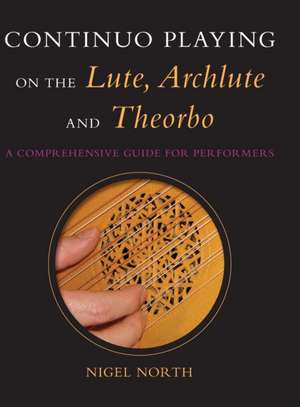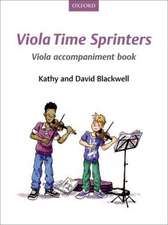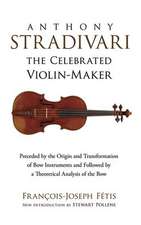Continuo Playing on the Lute, Archlute and Theor – A Comprehensive Guide for Performers
Autor N Northen Limba Engleză Hardback – 21 aug 1987
Preț: 417.51 lei
Nou
Puncte Express: 626
Preț estimativ în valută:
79.89€ • 83.25$ • 66.15£
79.89€ • 83.25$ • 66.15£
Carte tipărită la comandă
Livrare economică 03-17 aprilie
Preluare comenzi: 021 569.72.76
Specificații
ISBN-13: 9780253314154
ISBN-10: 0253314151
Pagini: 320
Dimensiuni: 225 x 288 x 24 mm
Greutate: 1.02 kg
Editura: MH – Indiana University Press
ISBN-10: 0253314151
Pagini: 320
Dimensiuni: 225 x 288 x 24 mm
Greutate: 1.02 kg
Editura: MH – Indiana University Press
Cuprins
List of illustrations
Preface
Acknowledgements
PART ONE; THE THEORBO, CHITARRONE AND ARCHLUTE
1 An Historical Background: Musical Qualities of each Instrument
The Italian tiorba or chitarrone
The Italian liuto of the seventeenth and eighteenth centuries
The theorbo and archlute in England
The theorbo and archlute in Germnay
The theorbo and archlute in France
Tunings
2 Practical Advice
Choosing an instrument
Size and type of instrument
Strings--number and disposition
Strings--metal or gut, single or double
Bass strings
Single or double strings on the theorbo
Choice of wood
Technique
Holding a theorbe or archlute
Right-hand technique
Hand position
Nails
Thumb
Fingers
Preparing scores
Scores
Figures
Tablature
3 List of Appropriate Repertory
Seventeenth--century Italy
Solo songa and madrigals
Cantatas
Instrumental music
Opera
Church music
Eighteenth-century Italy
Trio sonatas
Opera
Instrumental music
Cantatas
Seventeenth-century England
Solo songs (and dialogues, duets, etc.)
Instrumental music
Theatre and opera
Church and chapel
Eighteenth-century England
France
Solo songs
Cantatas
Instrumental music
Opera
Chuch music
Germany
Instrumental music
Songs and cantatas
Church music
Opera
PART TWO: HARMONY AND FIGURES
4 An harmonic precis
Common chords
Accidentals and figures
Dissonant chords
The dominant
5 etc. in relation to the dominant 7th
The diminished 7th
Discords caused by suspensions
5 Cadences, Sequences and Unfigured Basses
The rule of the octave
Cadences
4-3 cadence
Major 3rd in the final chord
65 4-3 45
3-4-4-3 45
Second type of cadence on the tonic
Imperfect cadences; half closes on the dominant
Basic harmonic sequences
Ascending sequences
Descending sequences
Quick basses and passing notes
Rests
6 Finer Points concerning Style, Technique and Performance
Chords
Number of voices
Doubling of voices
Phrasing
Hemiolas
Formation of chords
Chord spacing
Echoes and dynamics
Relationship of the accompaniment to the soloist
Voices to omit
Ensemble playing
The bass line
Playing with another continuo instrument
Organ
Melodic bass
Playing as the only continuo instrument
Music not requiring a melodic bass
Alteration of the written bass line
Sustaining the sound
Ties
16ft pitch
Eighteenth-century music for the German theorbo-lute
Accidentals in the bass
Tasto solo
AllÕunisono
Slurs
Arpeggiation
Spread chords
Free arpeggiation
ÔBreaking your partsÕ
Strumming (rasgueado)
Recitative
Accompanying recitative
Early seventeenth-century monody
Italian recitative
Chord positions
Full chords
Cadences
Two examples of eighteenth-century recitative
Ornamentation
Style
General guideline
When is ornamentation appropriate?
In ensemble
Basso continuo solos
Left hand graces
Cadences
Passing notes
Which ornaments to use
Left-hand graces: Italy before c1650
Left-hand graces: France, seventeenth-and eighteenth-century; Italy and Germany, post c1650; England, post c1630
Left-hand graces in chords
Separee (breaking the chord)
Eighteenth-century melodic ornamentation: Gasparini, Heinichen
PART THREE: FIRST PRACTICAL STEPS
7 Lute and Archlute
5 3 chords
Ground
The bergamasca (also known as ÔLes BouffonsÕ)
La folia
The passamezzo moderno and antico
The romanesca
The passacaglia
6 3 chords (1st inversions)
Cadences and sequences
Other chord shapes
8 Exercises and Musical Extracts from Seventeenth-and Eighteenth-century Sources
A sense of key (Gasparini, Matteis, Heinichen)
Mostly 6 and 7-6 (matteis)
All manner of dissonances (matteis, Gasparini, Charpentier, Vivaldi, Corelli, Heinichen,m Cima, Keller)
Quick basses (Campion, Telemann, Corelli, Matteis)
PART FOUR: THE THEORBO
9 An Introduction to the Theorbo
Solo repertory
Songs with tablature
Original tutors for the theorbo
Fleury, Bartolomi and Grenerin
Delair and Campion
10 The Theorbo, First Practical Steps
Reading in A
Solo pieces (Kapsberger, anon., Hurel, Castaldi, Wilson)
General advice on chord shapes and theorbo accompaniment
Chord shapes
5 3 chords
The bergamasca
Other theorbo chords
11 Original Exercises for Theorbo and Lute, with Tablature Cadenze finali (modena MS)
Two exercises by Matteis for the English theorbo
Examples of ÔBreaking your partsÕ (Mace)
La Regle des octaves (Campion)
Two examples for 11-course baroque lute in D minor tuning (vienna MS)
Examples for 11-course baroque lute in D minor tuning (Prague MS)
PART FIVE: MUSIC EXAMPLES
12 Music with Original Realized Accompaniments for the Theorbo
B. Castaldi, Quella crudel (1622)
F. Corradi, Baci cari e graditi (1616)
G.G. Kapsberger, Interrotte speranze (1612)
Anon., Sing aloud harmonious spheres (1687)
J. Wilson, Were thy heart soft (c1650)
13 Music with Editorial Realizations for Theorbo, English Theorbo in G, Archlute, 10-course Renaissance Lute and 13-course Baroque Lute
S. Le Camus, Amour, cruel amour (1678)--theorbo in A
M.P. de Monteclair, Air and Recitative from cantata La badine (c1709)--theorbo in A
C. Coleman, Wake, my Adonis (1652)--Engish theorbo in G
H. Purcell, Oh lead me (1698)--archlute in G
G.B. Riccio, Canzona (1620/I0--10-course Renaissance lute
A. Corellia, Vivace and adagio (1683)--theorbe in A
G.F. Handel, Recitative and aria (c1720)--archlute in G
G.P. Telemann, Toback (1733-5)--baroque lute
14 Music Examples without Realizations
Three English songs of the seventeenth century
H. Lawes, Amarillis, tear thy har (1678)
J. Blow, Clarona, lay aside your lute (1700)
H. Purcell, Music for a while (1702)
Three Italian instrumental pieces from the seventeenth century
S. Rossi, Sinfonia and Gagliarda (1608)
C. Monteverdi, Dances from Il ballo delle ingrate (1638)
N. Matteis, Sarabanda amorosa (c1685)
Two Italian songs of the seventeenth century
B. Marini, Invito a lÕAllegrezza: Ite ho mai (1622)
G. Frescobaldi, Sonetto spirituale (1630)
French Music
M. Lambert, Par mes chants (c1680)
F. Couperin, Prelude (1724)
Two arias from Italian cantatas of the eighteenth century
Anon., Aria from Cantata per leuto obbligato (c1720)
G.F. Handel, Aria from canta La bianca rosa (C1715)
Appendix: Song Translations
Notes
Music List
Select Bibliography
Preface
Acknowledgements
PART ONE; THE THEORBO, CHITARRONE AND ARCHLUTE
1 An Historical Background: Musical Qualities of each Instrument
The Italian tiorba or chitarrone
The Italian liuto of the seventeenth and eighteenth centuries
The theorbo and archlute in England
The theorbo and archlute in Germnay
The theorbo and archlute in France
Tunings
2 Practical Advice
Choosing an instrument
Size and type of instrument
Strings--number and disposition
Strings--metal or gut, single or double
Bass strings
Single or double strings on the theorbo
Choice of wood
Technique
Holding a theorbe or archlute
Right-hand technique
Hand position
Nails
Thumb
Fingers
Preparing scores
Scores
Figures
Tablature
3 List of Appropriate Repertory
Seventeenth--century Italy
Solo songa and madrigals
Cantatas
Instrumental music
Opera
Church music
Eighteenth-century Italy
Trio sonatas
Opera
Instrumental music
Cantatas
Seventeenth-century England
Solo songs (and dialogues, duets, etc.)
Instrumental music
Theatre and opera
Church and chapel
Eighteenth-century England
France
Solo songs
Cantatas
Instrumental music
Opera
Chuch music
Germany
Instrumental music
Songs and cantatas
Church music
Opera
PART TWO: HARMONY AND FIGURES
4 An harmonic precis
Common chords
Accidentals and figures
Dissonant chords
The dominant
5 etc. in relation to the dominant 7th
The diminished 7th
Discords caused by suspensions
5 Cadences, Sequences and Unfigured Basses
The rule of the octave
Cadences
4-3 cadence
Major 3rd in the final chord
65 4-3 45
3-4-4-3 45
Second type of cadence on the tonic
Imperfect cadences; half closes on the dominant
Basic harmonic sequences
Ascending sequences
Descending sequences
Quick basses and passing notes
Rests
6 Finer Points concerning Style, Technique and Performance
Chords
Number of voices
Doubling of voices
Phrasing
Hemiolas
Formation of chords
Chord spacing
Echoes and dynamics
Relationship of the accompaniment to the soloist
Voices to omit
Ensemble playing
The bass line
Playing with another continuo instrument
Organ
Melodic bass
Playing as the only continuo instrument
Music not requiring a melodic bass
Alteration of the written bass line
Sustaining the sound
Ties
16ft pitch
Eighteenth-century music for the German theorbo-lute
Accidentals in the bass
Tasto solo
AllÕunisono
Slurs
Arpeggiation
Spread chords
Free arpeggiation
ÔBreaking your partsÕ
Strumming (rasgueado)
Recitative
Accompanying recitative
Early seventeenth-century monody
Italian recitative
Chord positions
Full chords
Cadences
Two examples of eighteenth-century recitative
Ornamentation
Style
General guideline
When is ornamentation appropriate?
In ensemble
Basso continuo solos
Left hand graces
Cadences
Passing notes
Which ornaments to use
Left-hand graces: Italy before c1650
Left-hand graces: France, seventeenth-and eighteenth-century; Italy and Germany, post c1650; England, post c1630
Left-hand graces in chords
Separee (breaking the chord)
Eighteenth-century melodic ornamentation: Gasparini, Heinichen
PART THREE: FIRST PRACTICAL STEPS
7 Lute and Archlute
5 3 chords
Ground
The bergamasca (also known as ÔLes BouffonsÕ)
La folia
The passamezzo moderno and antico
The romanesca
The passacaglia
6 3 chords (1st inversions)
Cadences and sequences
Other chord shapes
8 Exercises and Musical Extracts from Seventeenth-and Eighteenth-century Sources
A sense of key (Gasparini, Matteis, Heinichen)
Mostly 6 and 7-6 (matteis)
All manner of dissonances (matteis, Gasparini, Charpentier, Vivaldi, Corelli, Heinichen,m Cima, Keller)
Quick basses (Campion, Telemann, Corelli, Matteis)
PART FOUR: THE THEORBO
9 An Introduction to the Theorbo
Solo repertory
Songs with tablature
Original tutors for the theorbo
Fleury, Bartolomi and Grenerin
Delair and Campion
10 The Theorbo, First Practical Steps
Reading in A
Solo pieces (Kapsberger, anon., Hurel, Castaldi, Wilson)
General advice on chord shapes and theorbo accompaniment
Chord shapes
5 3 chords
The bergamasca
Other theorbo chords
11 Original Exercises for Theorbo and Lute, with Tablature Cadenze finali (modena MS)
Two exercises by Matteis for the English theorbo
Examples of ÔBreaking your partsÕ (Mace)
La Regle des octaves (Campion)
Two examples for 11-course baroque lute in D minor tuning (vienna MS)
Examples for 11-course baroque lute in D minor tuning (Prague MS)
PART FIVE: MUSIC EXAMPLES
12 Music with Original Realized Accompaniments for the Theorbo
B. Castaldi, Quella crudel (1622)
F. Corradi, Baci cari e graditi (1616)
G.G. Kapsberger, Interrotte speranze (1612)
Anon., Sing aloud harmonious spheres (1687)
J. Wilson, Were thy heart soft (c1650)
13 Music with Editorial Realizations for Theorbo, English Theorbo in G, Archlute, 10-course Renaissance Lute and 13-course Baroque Lute
S. Le Camus, Amour, cruel amour (1678)--theorbo in A
M.P. de Monteclair, Air and Recitative from cantata La badine (c1709)--theorbo in A
C. Coleman, Wake, my Adonis (1652)--Engish theorbo in G
H. Purcell, Oh lead me (1698)--archlute in G
G.B. Riccio, Canzona (1620/I0--10-course Renaissance lute
A. Corellia, Vivace and adagio (1683)--theorbe in A
G.F. Handel, Recitative and aria (c1720)--archlute in G
G.P. Telemann, Toback (1733-5)--baroque lute
14 Music Examples without Realizations
Three English songs of the seventeenth century
H. Lawes, Amarillis, tear thy har (1678)
J. Blow, Clarona, lay aside your lute (1700)
H. Purcell, Music for a while (1702)
Three Italian instrumental pieces from the seventeenth century
S. Rossi, Sinfonia and Gagliarda (1608)
C. Monteverdi, Dances from Il ballo delle ingrate (1638)
N. Matteis, Sarabanda amorosa (c1685)
Two Italian songs of the seventeenth century
B. Marini, Invito a lÕAllegrezza: Ite ho mai (1622)
G. Frescobaldi, Sonetto spirituale (1630)
French Music
M. Lambert, Par mes chants (c1680)
F. Couperin, Prelude (1724)
Two arias from Italian cantatas of the eighteenth century
Anon., Aria from Cantata per leuto obbligato (c1720)
G.F. Handel, Aria from canta La bianca rosa (C1715)
Appendix: Song Translations
Notes
Music List
Select Bibliography
Recenzii
" . . . a valuable book. It is an important link between the unknown of the Renaissance and the present." The Triangle of Mu Phi Epsilon"Straightforward practicality is the most outstanding characteristic of this book." Continuo". . . a fine and very welcome book that is likely to remain the high standard of lute continuo instruction for some time to come." Sixteenth Century Journal
" ... a valuable book. It is an important link between the unknown of the Renaissance and the present." The Triangle of Mu Phi Epsilon "Straightforward practicality is the most outstanding characteristic of this book." Continuo "... a fine and very welcome book that is likely to remain the high standard of lute continuo instruction for some time to come." Sixteenth Century Journal
" ... a valuable book. It is an important link between the unknown of the Renaissance and the present." The Triangle of Mu Phi Epsilon "Straightforward practicality is the most outstanding characteristic of this book." Continuo "... a fine and very welcome book that is likely to remain the high standard of lute continuo instruction for some time to come." Sixteenth Century Journal
Descriere
Discusses the history of the lute, the archlute, and the theorbo










